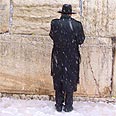

TEL AVIV - Tamar Yellin's debut novel, “The Genizah at the House of Shepher,” quickly sweeps readers up in an exhaustively researched, intelligent saga about the whereabouts of the only true handwritten copy of the Bible.
As in the author's real life, Shulamit is also a bible scholar, who has drifted into a lonely, drab world of academic life in England where she was raised by an English mother and Israeli father. An unexplainable yearning for a revival of past memories brings her back to Israel and to a life of meaning. After many years of absence, she visits the ramshackle home of her grandparents in Jerusalem.
Her uncle Coby, now residing in her grandparent's home, exposes her to the mystery of the missing text, protected until death by her great, great grandfather. The text, found in the attic of the old house is known as the Shepher Codex. It pertains to the Keter Aram Soba, regarded by many as the most perfect text of the Bible in existence. Where did it originate, how did it fall into the hands of the Shepher family? Who is the true owner?
The storyline begins with Shulamit's great, great grandfather Shalom Shachne Yellin, the greatest corrector of scrolls in Lithuania, who left his hometown of Skidel in 1854 for the holy city of Jerusalem. On arrival there, he gets caught up in a series of events that leads to the reconstruction of the holy biblical text safeguarded by the Jewish community in Allepo, Syria.
Shulamit's curiosity over the authenticity of her great grandfather's text sets the storyline on an unexpected course as it becomes a probing search into her distant past.
A family feud over ownership of the Codex is intertwined with the mysterious appearance of Gideon, who also claims first right to the document, "as the property of the elders of the tribe of Dan."
Gideon's role serves to rekindle her feelings for a past love, to probe her parents' mismatched marriage and wonder about the long lost desires the mysterious Gideon awakens in her.
The mystery crops up like a Jewish, low-profile version of “The Da Vinci Code.” Shulamit is like novelist Dan Brown's cryptographer Sophie Neveu, who sets out on a journey to seek the secret her grandfather was charged to protect.
Shulamit's great grandfather is also charged with the protection of the key to the true text, which mysteriously disappears in 1915. Its reappearance in real life is the basis for Yellin's novel.
As in “The Da Vinci Code,” Yellin's book challenges readers' minds with a fair measure of intrigue and scholarly adventure, albeit its biblical topic.
Rich in fascinating detail, typical wit and humor, Yellin skillfully weaves a story spanning four generations.
Never ceasing to cast humorous judgment on herself and her family, she reveals the loves, hates and the intrigues of her family's life.
She calls her family history a "mythical" history eloquently describing it as "a mass of conflated texts and contradictory traditions. An obscure document full of holes. A ramshackle narrative stuffed with trivia and repetition, stitched together with heresy and anecdote and perhaps lies." This is the premise on which she so freely mixes fact with fiction.
Without burdening the reader, the author skips back and forth in time as she intermittently darts through distant generations and changing geographies. She traces her roots from the 10 lost tribes to their dispersion worldwide, giving an instant overview of the wandering Jew.
The book is written with the authoritative tone of one who is clearly familiar with the subject matter. Yellin's in-depth knowledge of her subject gives readers the confidence that they can rely on the authenticity of the scholarly information, albeit it's fictional wrapping.
Yellin's love-hate descriptions of Jerusalem reflect her distinct style of writing, short staccato sentences peppered with sarcasm and humor.
"There was the city of streets and there was the city of roofs. It was possible to cross Jerusalem without setting foot on the ground. Every cat knew this and so did every robber."
The Genizah at the House of Shepher by Tamar Yellin
ISBN 1 59264 085 0, hardcover, $19.95
Published by Toby Press















